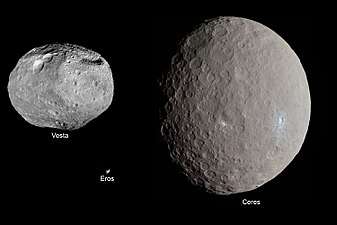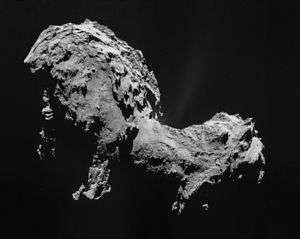HAMMER (spacecraft)
Hyper-velocity Asteroid Mitigation Mission for Emergency Response (HAMMER) is a concept study by NASA on a spacecraft (8 tonnes) capable of detonating a nuclear bomb to deflect an asteroid, if it was on a collision course to Earth. The study is a collaboration between the National Nuclear Security Administration, NASA, and two Energy Department weapons labs.[1][2][3]
Bennu
NASA is working on a modelling study that considers the asteroid 101955 Bennu, which has a diameter of 246 meters and capable of a 1.15 gigaton impact, as a modelling target for the HAMMER concept.[4][5] It is circling the Sun at 63,000 mph and 54 million miles from the Earth. [6] Bennu was first discovered in 1999 and on 21 September 2135, it has a 1 in 2,700 chance to hit the Earth. [7]
The two realistic responses considered in the study are the use of a spacecraft functioning as either a kinetic impactor or a nuclear explosive carrier to deflect the approaching asteroid.[8]
See also
References
- ↑ Khartoum, Sarah (15 March 2018). "Nasa draws up plans for huge spacecraft to blow up doomsday asteroid". The Telegraph. Retrieved 17 March 2018.
- ↑ Vergano, Dan (7 March 2018). "Government Scientists Have A Plan For Blowing Up Asteroids With A Nuke". BuzzFeed. Retrieved 17 March 2018.
- ↑ Parsons, Jeff (16 March 2018). "NASA building 'HAMMER' spacecraft to save Earth from cataclysmic asteroid impact". Mirror. Retrieved 17 March 2018.
- ↑ Whitwam, Ryan (9 March 2018). "NASA Designs HAMMER Spacecraft to Deflect or Nuke Dangerous Asteroids". ExtremeTech. Retrieved 18 March 2018.
- ↑ Vergano, Dan (7 March 2018). "Government Scientists Have A Plan For Blowing Up Asteroids With A Nuke". BuzzFeed. Retrieved 18 March 2018.
- ↑ "NASA May Build 'HAMMER' Spacecraft To Blow Up Earth-Bound Asteroid". NDTV. 16 March 2018. Retrieved 18 March 2018.
- ↑ Mamiit, Aaron (11 March 2018). "NASA HAMMER Spacecraft May Save The World In The Future From An Incoming Asteroid". TechTimes. Retrieved 18 March 2018.
- ↑ Options and uncertainties in planetary defense: Mission planning and vehicle design for flexible response. Acta Astronautica. Volume 143, February 2018, Pages 37-61. Brent W. Barbee, Megan Bruck Syal, etal. doi:10.1016/j.actaastro.2017.10.021.



